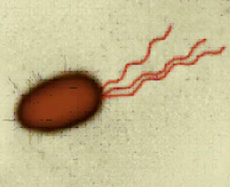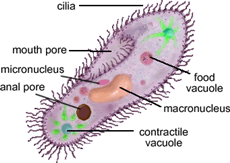Agriculture
Flagella and cilia are hairlike structures,made primarily of protein, found on the surfaces of cells and used for movement by microorganisms and some specialized cells, such as the gametes of certain plants with motile sperm. Because flagella and cilia are so similar, many scientists use the term ?undulipodia? for both in reference to eukaryotic organisms.
Although the term ?flagellum? is used in reference to both prokaryotes (archaea and bacteria) and eukaryotes (fungi, protists, plants, and animals), the structure and mechanism of action of this structure in prokaryotes are quite different from the structure and mechanism of action in eukaryotes.
Eukaryotic flagella and cilia, however, are structurally and functionally identical. The differences between them are in their number, length, and position. Flagella are less numerous, longer, and usually polar, while cilia are more numerous and shorter, covering much of the cell?s surface.
Because the dividing line between eukaryotic flagella and cilia is not precise, many scientists use the term undulipodia as a collective word for both eukaryotic flagella and cilia. In some algae, other protists, and the gametes of certain plants with motile sperm, flagella and cilia can occur.
Bacterial Flagella
Bacterial flagella are composed of a single protein called flagellin. Molecules of this globular protein are stacked to form a thin filament approximately 0.01-0.015 micrometer in diameter. The filament protrudes through the cell wall at the tip of the bacterium (polar flagella) or over the entire surface of the bacterium (peritrichous flagella).
Spirochetes are unusual in this regard because the flagella do not pierce the cell wall but are located in the space between it and the plasma membrane. The base of each flagellum connects to a rotary motor anchored in the plasma membrane.
The cell provides energy to the motor, which then rotates the flagellum to allow cell movement. Rotational movement may be counter-clockwise, which leads to generally straight-line motion, or clockwise, which leads to a more random tumbling motion.
Eukaryotic Flagella and Cilia
Eukaryotic flagella and cilia, or undulipodia, are more complex and larger (approximately 0.25 micrometer in diameter) than their prokaryotic counterparts. The main component of these eukaryotic structures is the microtubule; a long, cylindrical structure composed of tubulin proteins. In eukaryotic flagella and cilia, two central microtubules are surrounded by a circular arrangement of nine microtubule pairs.
Eukaryotic flagella and cilia also contain more than five hundred other proteins, including dynein and kinesin, motor proteins that use cell energy to slide the microtubules past each other, causing an undulating motion (hence the name undulipodium). Unlike bacterial flagella, eukaryotic flagella and cilia are considered to be intracellular structures because they are covered by a continuation of the plasma membrane.
Although absent from fungi, undulipodia are found inmany protists and in some plants. Unicellular algae (such as Chlamydomonas and Euglena) and colonial algae (Volvox) use undulipodia for locomotion. Multicellular algae (Phaeophyta, Rhodophyta) produce flagellated sperm.
Among the true plants, bryophytes (Hepatophyta, Anthocerotophyta, and Bryophyta), ferns and their allies (Psilotophyta, Lycophyta, Sphenophyta, and Pterophyta), and some gymnosperms (Cycadophyta and Ginkgophyta) also produce flagellated sperm. Other gymnosperms (Coniferophyta) and angiosperms (Anthophyta)do not produce cells with flagella or cilia.
- Euglenoids
Euglenoids Organisms called euglenoids, the algal phylum Euglenophyta in the kingdom Protista, make up a large group of common microorganisms numbering between 750 and 900 known species. Euglenoids can be found in both fresh and stagnant water. Some genera...
- Eukaryotic Cells
Eukaryotic cells (as opposed to prokaryotic cells) have internal, membrane-bound organelles and a distinct nucleus that physically separates the genetic material of the cell from the all of the other parts of the cell. All protists, fungi, plants, and...
- Fluorescent Staining Of Cytoskeletal Elements
Fluorescent antibody staining is a precise technique for marking elements of the cytoskeleton so they become visible under a microscope. The technique has revealed much about the location and functions of the cytoskeleton within a cell. It also offers...
- Green Algae
Green AlgaeThe green algae are a diverse group of eukaryotic organisms classified in the phylum Chlorophyta. They are considered eukaryotic because individual cells possess a prominent structural feature known as a nucleus, which houses the chemicals...
- Prokaryotes
ProkaryotesProkaryotes are one of two types of cell that form living organisms. Prokaryotic cells lack a nucleus and other organelles found in eukaryotic cells. Prokaryotes include the unicellular life-forms found in two of the three domains of life,...
Agriculture
Flagella and Cilia
 |
| Flagella and Cilia |
Although the term ?flagellum? is used in reference to both prokaryotes (archaea and bacteria) and eukaryotes (fungi, protists, plants, and animals), the structure and mechanism of action of this structure in prokaryotes are quite different from the structure and mechanism of action in eukaryotes.
Eukaryotic flagella and cilia, however, are structurally and functionally identical. The differences between them are in their number, length, and position. Flagella are less numerous, longer, and usually polar, while cilia are more numerous and shorter, covering much of the cell?s surface.
Because the dividing line between eukaryotic flagella and cilia is not precise, many scientists use the term undulipodia as a collective word for both eukaryotic flagella and cilia. In some algae, other protists, and the gametes of certain plants with motile sperm, flagella and cilia can occur.
Bacterial Flagella
 |
| Bacterial Flagella |
Spirochetes are unusual in this regard because the flagella do not pierce the cell wall but are located in the space between it and the plasma membrane. The base of each flagellum connects to a rotary motor anchored in the plasma membrane.
The cell provides energy to the motor, which then rotates the flagellum to allow cell movement. Rotational movement may be counter-clockwise, which leads to generally straight-line motion, or clockwise, which leads to a more random tumbling motion.
Eukaryotic Flagella and Cilia
 |
| Eukaryotic Flagella and Cilia |
Eukaryotic flagella and cilia also contain more than five hundred other proteins, including dynein and kinesin, motor proteins that use cell energy to slide the microtubules past each other, causing an undulating motion (hence the name undulipodium). Unlike bacterial flagella, eukaryotic flagella and cilia are considered to be intracellular structures because they are covered by a continuation of the plasma membrane.
 |
| Pharmacy in vegetables |
Among the true plants, bryophytes (Hepatophyta, Anthocerotophyta, and Bryophyta), ferns and their allies (Psilotophyta, Lycophyta, Sphenophyta, and Pterophyta), and some gymnosperms (Cycadophyta and Ginkgophyta) also produce flagellated sperm. Other gymnosperms (Coniferophyta) and angiosperms (Anthophyta)do not produce cells with flagella or cilia.
- Euglenoids
Euglenoids Organisms called euglenoids, the algal phylum Euglenophyta in the kingdom Protista, make up a large group of common microorganisms numbering between 750 and 900 known species. Euglenoids can be found in both fresh and stagnant water. Some genera...
- Eukaryotic Cells
Eukaryotic cells (as opposed to prokaryotic cells) have internal, membrane-bound organelles and a distinct nucleus that physically separates the genetic material of the cell from the all of the other parts of the cell. All protists, fungi, plants, and...
- Fluorescent Staining Of Cytoskeletal Elements
Fluorescent antibody staining is a precise technique for marking elements of the cytoskeleton so they become visible under a microscope. The technique has revealed much about the location and functions of the cytoskeleton within a cell. It also offers...
- Green Algae
Green AlgaeThe green algae are a diverse group of eukaryotic organisms classified in the phylum Chlorophyta. They are considered eukaryotic because individual cells possess a prominent structural feature known as a nucleus, which houses the chemicals...
- Prokaryotes
ProkaryotesProkaryotes are one of two types of cell that form living organisms. Prokaryotic cells lack a nucleus and other organelles found in eukaryotic cells. Prokaryotes include the unicellular life-forms found in two of the three domains of life,...
